Contributory members are able to log private notes and comments about each site
Sites Anne T has logged. View this log as a table or view the most recent logs from everyone
Millstone Burn 2dd
Trip No.71 Entry No.4 Date Added: 8th May 2018
Site Type: Rock Art
Country: England (Northumberland)
Visited: Yes on 7th May 2018. My rating: Condition 2 Ambience 3 Access 4
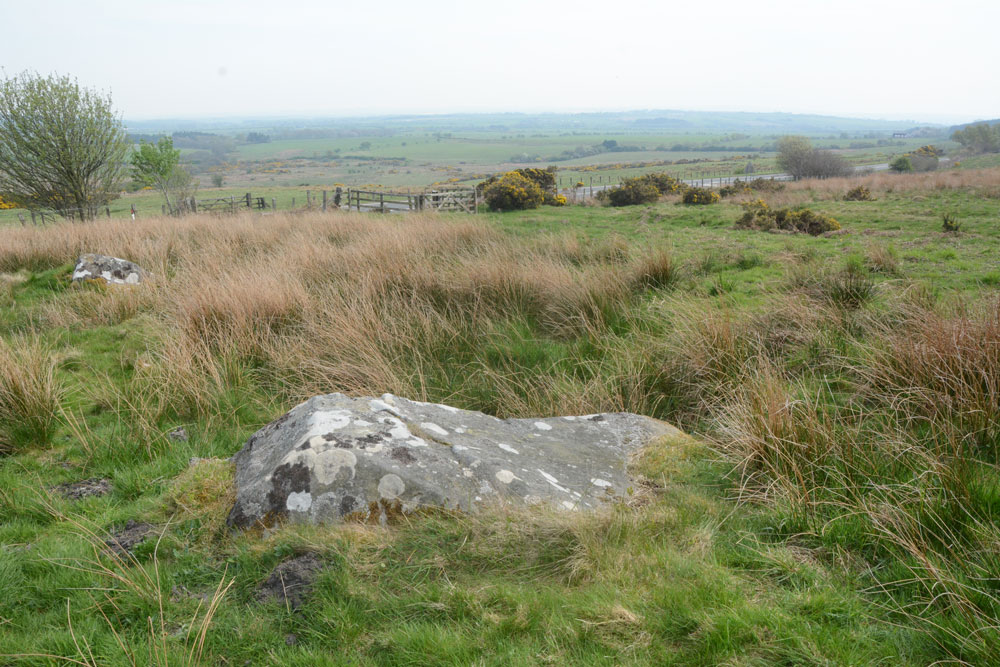
Millstone Burn 2dd submitted by Anne T on 8th May 2018. Millstone Burn 2dd panel, looking east across the A687.
(View photo, vote or add a comment)
Log Text: Millstone Burn 2dd: only 15m away from Millstone Burn 2d, and relatively easy to find amongst all the other boulders in the field. As these motifs are on top of the rock, they must have been designed to have been seen as you were coming down the hillside.
This rock looks very different shapes depending on what angle you view it at. We had huge difficulty making out any cup marks at all beneath the lichen and moss, although there are some grooves, which look as if they have been created (enhanced?) by rainwater trickling down and over the side of the rock over the years.
Not the best example of rock art we've seen, but one to tick off the list.
Millstone Burn 2e
Trip No.71 Entry No.5 Date Added: 9th May 2018
Site Type: Rock Art
Country: England (Northumberland)
Visited: Yes on 7th May 2018. My rating: Condition 2 Ambience 3 Access 4
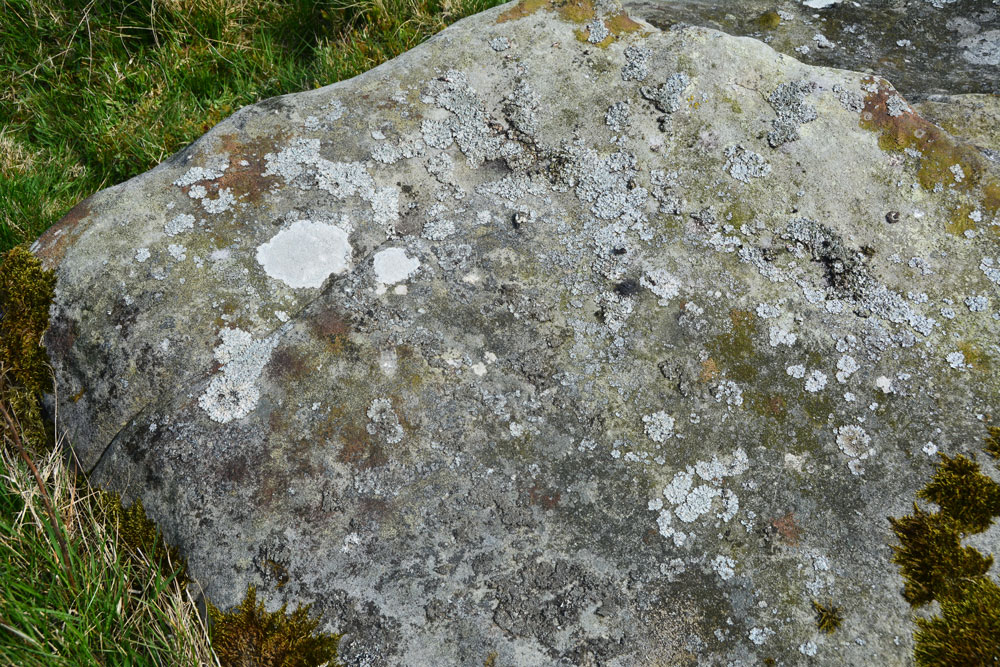
Millstone Burn 2e submitted by Anne T on 9th May 2018. In typical Tate fashion, we didn't remember to take any water along to try and highlight the motifs. We did struggle to find them!
(View photo, vote or add a comment)
Log Text: Millstone Burn 2e: This rock is not far upslope from Millstone Burn 2dd and 2d. Again, without GPS we would have struggled to find this rock, and we did struggle to identify any of the motifs - Beckensall described these as two ringed cups and two other cups, one with a natural groove leading to it and a pecked groove leading away from the ring. By the time of the NADRAP survey, they recorded a cup and very thin ring with groove running to the northern edge of the outcrop.
This stone was very interesting as downslope it had a step in it, and not only was there a channel wearing, but there were green water stains from where rain water had trickled down the slight slope of the rock downhill.
These motifs must have been placed to have been seen as you were coming down or up the slope.
Millstone Burn 1d
Trip No.71 Entry No.6 Date Added: 7th May 2018
Site Type: Rock Art
Country: England (Northumberland)
Visited: Yes on 7th May 2018. My rating: Condition 2 Ambience 4 Access 4
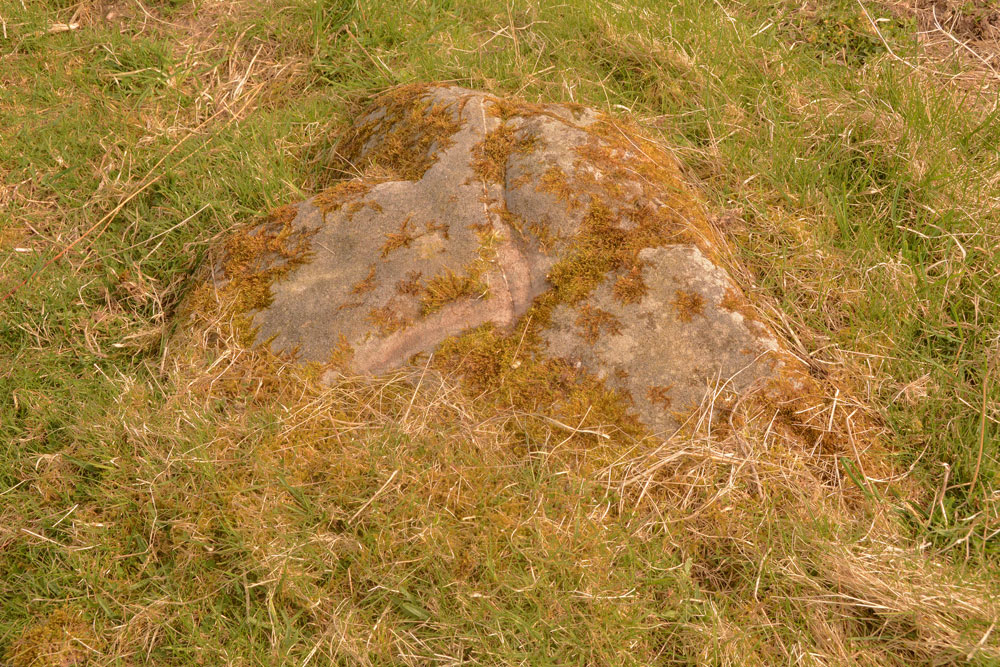
Millstone Burn 1d submitted by Anne T on 7th May 2018. Millstone Burn 1d from a different angle, showing the 'scar' across the middle of the rock, which looks relatively recent.
(View photo, vote or add a comment)
Log Text: Millstone Burn 1d: This rock art panel is just to the east of the A697 and largely covered in turf. There is a deep scar in the rock which looks relatively recent. It also has a curious vein of quartz which runs through the rock.
Millstone Burn 1e
Trip No.71 Entry No.6 Date Added: 9th May 2018
Site Type: Rock Art
Country: England (Northumberland)
Visited: Yes on 7th May 2018. My rating: Condition 2 Ambience 3 Access 4
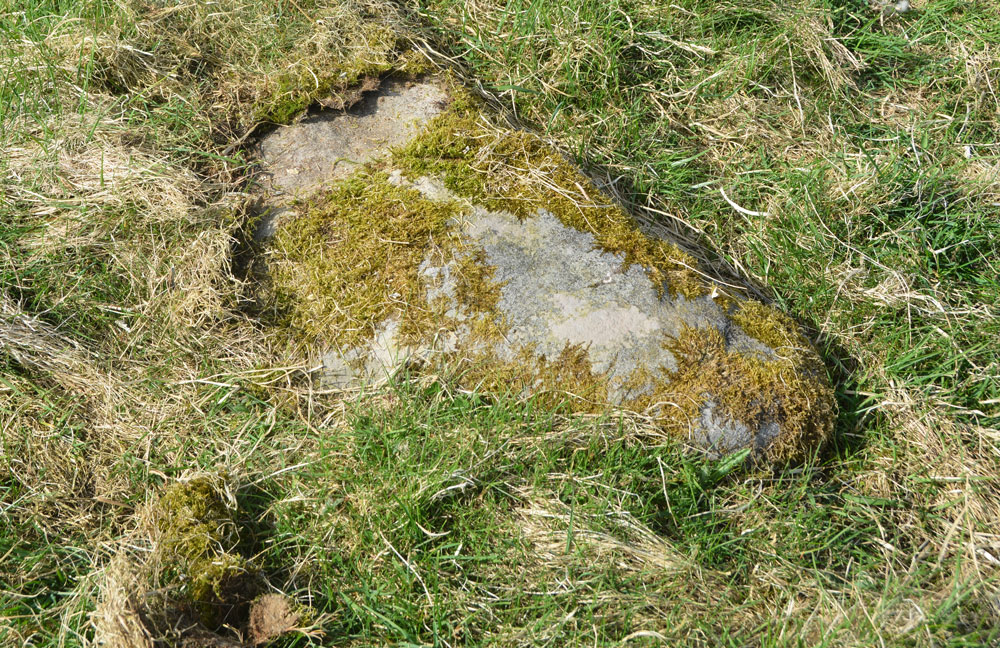
Millstone Burn 1e submitted by Anne T on 9th May 2018. Millstone Burn 1e was too heavily under moss to make out any motifs at all. We didn't want to move any moss, so left the panel as it was.
(View photo, vote or add a comment)
Log Text: Millstone Burn 1e: On the eastern side of the A697, not far from the gate into the field. This was the stone at the grid reference given, but was almost completely buried under moss/turf, with one end of it seeming to have been grazed by farm machinery, which had taken off the moss and a shallow layer of stone. We left the moss as it was, not wanting to harm the motifs (but then NADRAP said they didn't observe anything).
Millstone Burn 1c
Trip No.71 Entry No.8 Date Added: 9th May 2018
Site Type: Rock Art
Country: England (Northumberland)
Visited: Yes on 7th May 2018. My rating: Condition 2 Ambience 3 Access 4
Millstone Burn 1c submitted by SolarMegalith on 7th Jun 2013. General view of the cup-marked boulder as seen from the east (photo taken on June 2013).
(View photo, vote or add a comment)
Log Text: Millstone Burn 1c: This panel was very near the road (some motorists tooted their horns as they went past) and parts of it were under turf and moss. Part of the line of cups visible on the ERA photographs were covered by moss, which we left undisturbed. It was difficult to distinguish any other cups on the rock, despite having the ERA images on my phone to compare it to.
Great North Museum
Trip No.72 Entry No.1 Date Added: 10th May 2018
Site Type: Museum
Country: England (Tyne and Wear)
Visited: Yes on 4th May 2018. My rating: Condition 4 Ambience 4 Access 5

Great North Museum submitted by durhamnature on 25th Jul 2012. The Great North Museum, formerly the Hancock. The best museum in the north east.
(View photo, vote or add a comment)
Log Text: Great North Museum, Newcastle: The last time I visited here was some 8 or 9 years ago, with some police officers from York. We spent most of our time at the Hadrian's Wall exhibit, with them comparing Roman soldier's battle kit to their modern day riot gear. I found the layout of the galleries confusing, and the signs not terribly clear, but we spent a good couple of hours looking at Anglo Saxon artefacts and rock art. I also enjoyed the Ancient Egyptian gallery, and found the Mouse House for under 5's - definitely a place to return to with my grand-daughter.
I'd love to come back to their library sometime, which is open to all. The coffee shop on the first floor was also good.
Great North Museum (Anglo Saxon Stones)
Trip No.72 Entry No.2 Date Added: 13th May 2018
Site Type: Museum
Country: England (Tyne and Wear)
Visited: Yes on 4th May 2018. My rating: Condition 3 Ambience 4 Access 5

Great North Museum (Anglo Saxon Stones) submitted by Anne T on 11th May 2018. This is the front of the Rothbury Cross head, described as one of the finest pieces of Anglo-Saxon sculpture from the Kingdom of Northumbria. It is carved with scenes of the crucifixion and other motifs. The museum sign says it was made about 100 years after the Lindisfarne Gospels but "clearly belongs to the same artistic tradition." From the collection of the Society of Antiquities of Newcastle upon Tyne. Submitted with the kind permission of the Great North Museum.
(View photo, vote or add a comment)
Log Text: Great North Museum, Anglo Saxon Exhibit: A small but nicely presented collection of Anglo Saxon cross fragments and grave goods. Ground floor. See general SID page for Great North Museum for main visit report.
Great North Museum (Rock Art)
Trip No.72 Entry No.3 Date Added: 13th May 2018
Site Type: Museum
Country: England (Tyne and Wear)
Visited: Yes on 4th May 2018. My rating: Condition 3 Ambience 4 Access 5
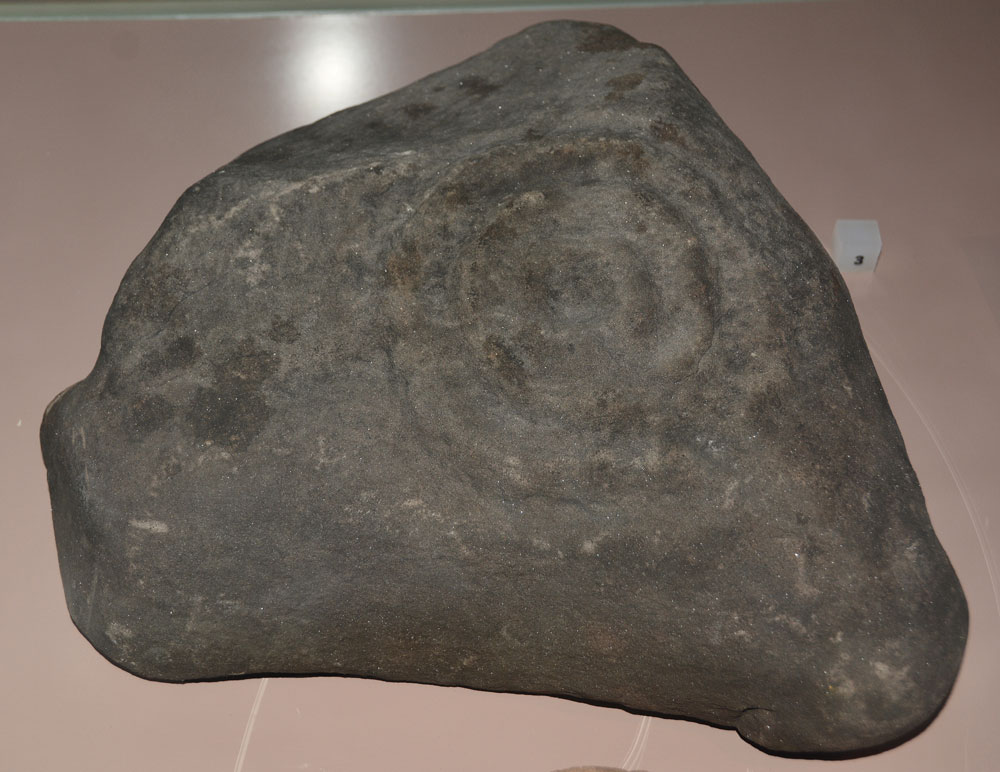
Great North Museum (Rock Art) submitted by Anne T on 10th May 2018. On display in a case in the Prehistoric display on the ground floor. Comparing photographs, I think this is Fowberry Moor Farm, Island/Deershed Plantation Panel, ERA-1842, Beckensall 179. The panel is stained dark red due to peat staining.
Submitted with the kind permission of the Great North Museum.
(View photo, vote or add a comment)
Log Text: Great North Museum (Rock Art): in the 'Prehistoric' Exhibition on the ground floor (see the general Great North Museum page for full visit report). A real shame that most of the exhibits were behind glass, and very close together, which made them difficult to photograph. It was nice to see some of the Beckensall RA stones which had been donated to the museum - but I wonder where the rest are, and there are quite a few. These seemed relatively poor examples given the photos I've seen on the ERA website. Much enjoyed seeing these.
Carby Hill
Trip No.73 Entry No.1 Date Added: 14th May 2018
Site Type: Ancient Village or Settlement
Country: Scotland (Scottish Borders)
Visited: Yes on 13th May 2018. My rating: Condition 3 Ambience 5 Access 4
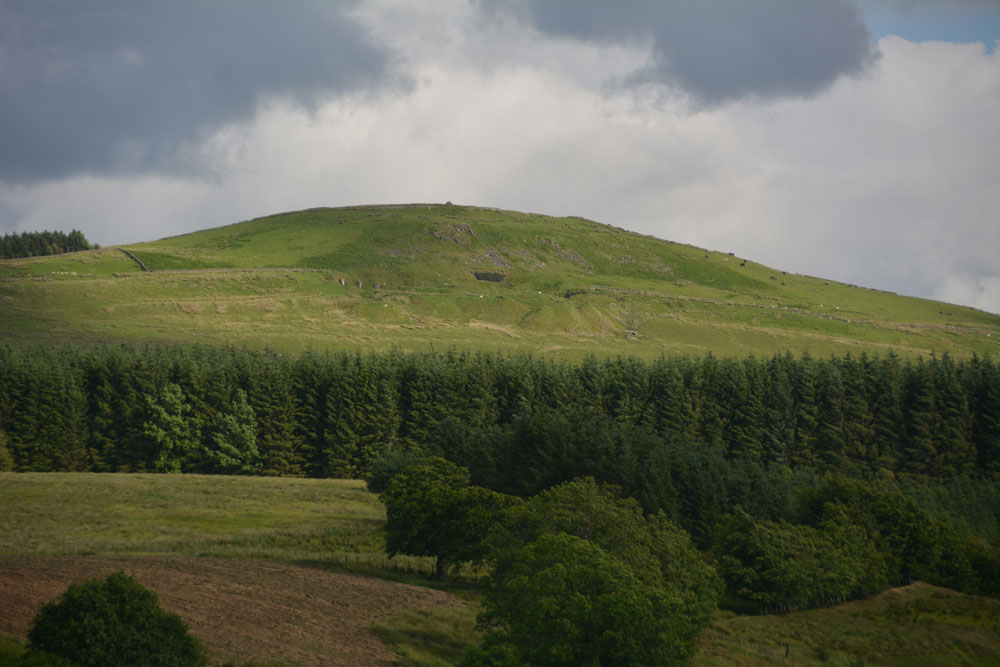
Carby Hill submitted by Anne T on 25th Jun 2017. We only saw Carby Hill Settlement from the Milnholm Cross just south of Newcastleton, then again from the track by the quarry just below the fort/settlement. When we arrived, we saw some enormous cattle grazing the site. Even my husband balked, and he was brought up on a farm and is used to these beasts. Looking forward to a return trip in the not too distant future - it looks amazing.
(View photo, vote or add a comment)
Log Text: Carby Hill Hillfort/Settlement, Scottish Borders: Literally just across the border from England, we parked by the cattle grid at NY 48834 83744, opposite the bungalow/farm. Just to our south east, there was (unusually for Scotland) a footpath sign which led up to the hillfort, so we decided to follow it. A mistake. The gate into the field of sheep was wired shut, so we had to duck under the electric fence. Following the slope uphill, we had to tackle three or four deep field drains, full of running water.
It wasn’t until we got towards the top of the slope that the walls of the settlement came into view. And what walls.
This is a really brilliant site. The last time we tried to get up here, there was an absolutely monumentally huge bull and cattle on top of the hill. This time, there were only sheep and their lambs. With 360 degree views, it was superb.
The interior of the hillfort is not large, but we made out four, if not five, hut circles, still with their banks intact, plus a watchtower in the north eastern corner.
Not much of the walls remains on the north/north eastern side, but there are lower banks of stones. We walked round the outer edge of the wall, to where stones have been piled up to form a modern cairn, overlooking the Liddel Water valley below. We descended the hill from the western side of the hillfort, which avoided the field drains, and a much easier walk.
Will O'Greena's Stane
Trip No.73 Entry No.2 Date Added: 14th May 2018
Site Type: Standing Stone (Menhir)
Country: Scotland (Scottish Borders)
Visited: Saw from a distance on 13th May 2018. My rating: Condition -1 Ambience 4 Access 4
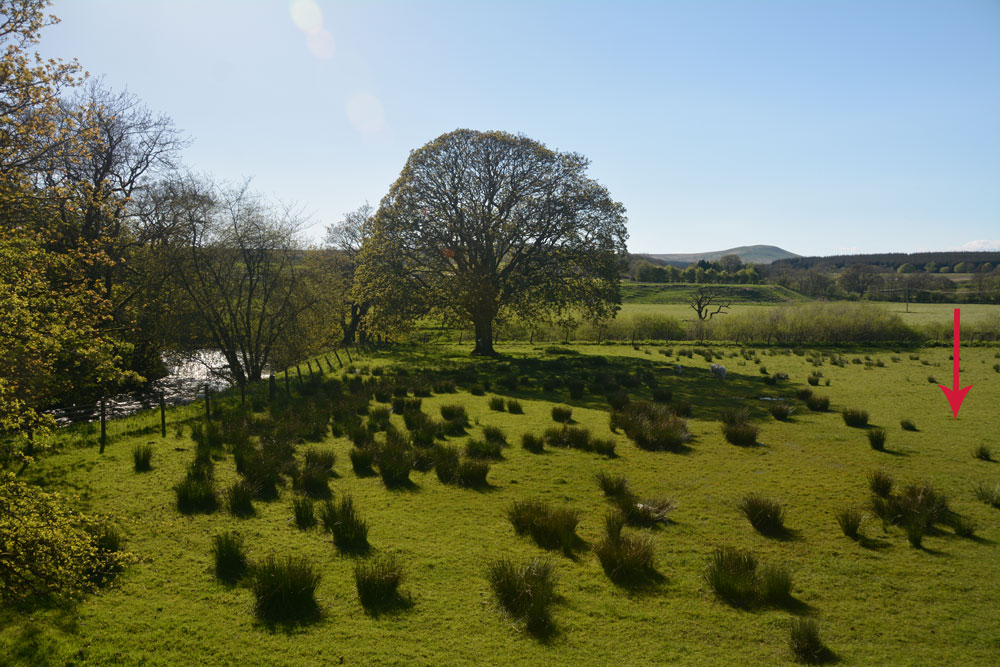
Will O'Greena''s Stane submitted by Anne T on 14th May 2018. The red arrow points to the approximate grid reference where this prehistoric standing stone was originally sited.
(View photo, vote or add a comment)
Log Text: Will O'Greena's Stone, Kersehopefoot: What a beautiful spot, where Kersehope Burn meets Liddel Water. Certainly very historic, if you can reconcile Canmore's version with the interpretation board on site. On the Reiver's Trail, its an easy (if wet, due to heavy rain) walk along the old railway embankment, although to descend into the field between the embankment and the river to find the stone, it's a six foot or so slither down the embankment. We walked up and down, down and up, trying to find any sandstone boulder/stone which matched the description on Canmore (thank goodness for a mobile signal to call up the record 'in the field').
I eventually spotted this stone next to a gate/fence backing onto private property. The strong fence with two lines of barbed wire made me think twice about hopping across the fence, and we could see no obvious other route into the field to check. A beautiful spot but so disappointing that, having mentioned this famous stone, they hadn't made sure it (what remained of it) could be seen.
National Museum of Scotland (Early Christian Stones)
Trip No.74 Entry No.1 Date Added: 20th May 2018
Site Type: Ancient Cross
Country: Scotland (Midlothian)
Visited: Yes on 17th May 2018. My rating: Condition 4 Ambience 4 Access 5
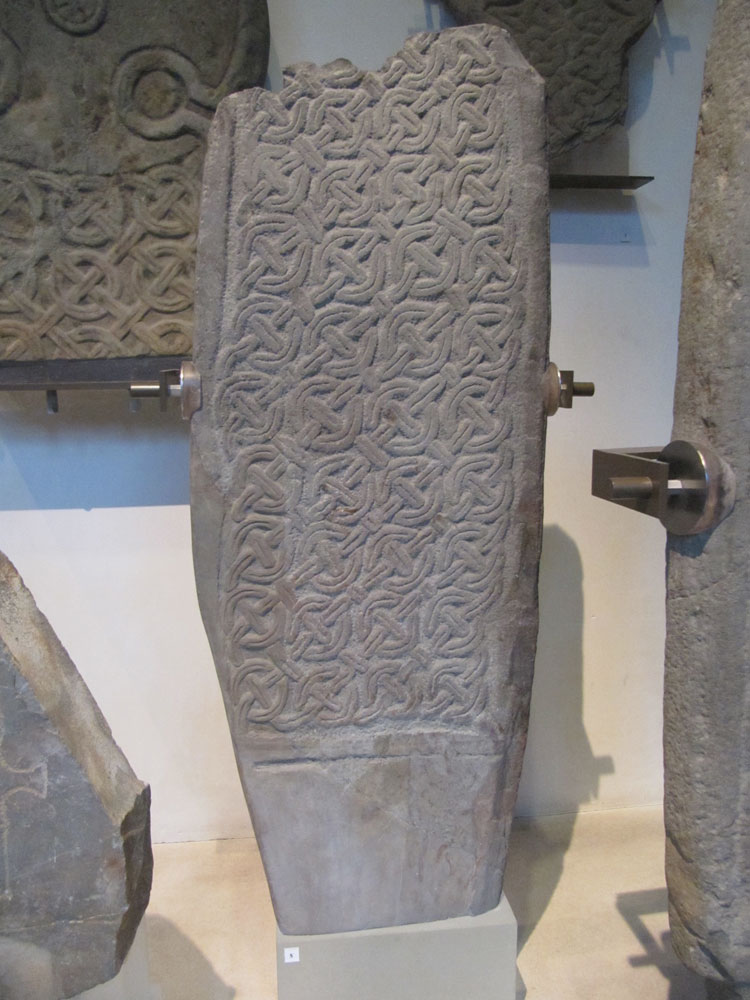
National Museum of Scotland (Early Christian Stones) submitted by Anne T on 18th Jan 2018. This Whithorn Style Cross Shaft is on display in the 'Early People's Exhibition on Level -1. It comes from Craiglemine, Glasserton, Wigtownshire near Whithorn, Dumfries and Galloway. Submitted with the kind consent of National Museums of Scotland. Exhibit X.IB 122. Dates from 900-100 AD.
(View photo, vote or add a comment)
Log Text: Early Christian Stones at the National Museum of Scotland: We returned to go to the Research Library to find out more about the Pictish Stones, and to photograph some more exhibits, only to find Tim Peake's Spacecraft had arrived that morning, with a PR exercise in full swing and the gallery we needed to get to had been closed off until 2pm (didn't say anything about this on the web site, until we dug deeper into the events schedule). Fortunately, by the time we'd been and looked at some casts of grave slabs in part of the Kingdom of the Scots exhibit, the gallery we wanted to go to was temporarily re-opened and we managed to get in and out in between the various waves of visitors and school children. The space craft was minute, and like a cross between something out of Dr. Who and The Clangers. Apparently, Tim Peake had attended earlier that morning, but we'd missed him.
I spent an hour in the research library, coming away with some photocopies and the names/details of a number of reference books.
We also managed to go into the 'Early People's Exhibit' which had been closed during our last visit - more Pictish Symbol stones and Early Christian stones, which more than made up for the disappointment of having arrived at 10.30am and being told we'd have to wait until 2pm to get in because of Tim Peake!
National Museum of Scotland (Pictish Stones)
Trip No.74 Entry No.2 Date Added: 20th May 2018
Site Type: Museum
Country: Scotland (Midlothian)
Visited: Yes on 17th May 2018. My rating: Condition 4 Ambience 4 Access 5
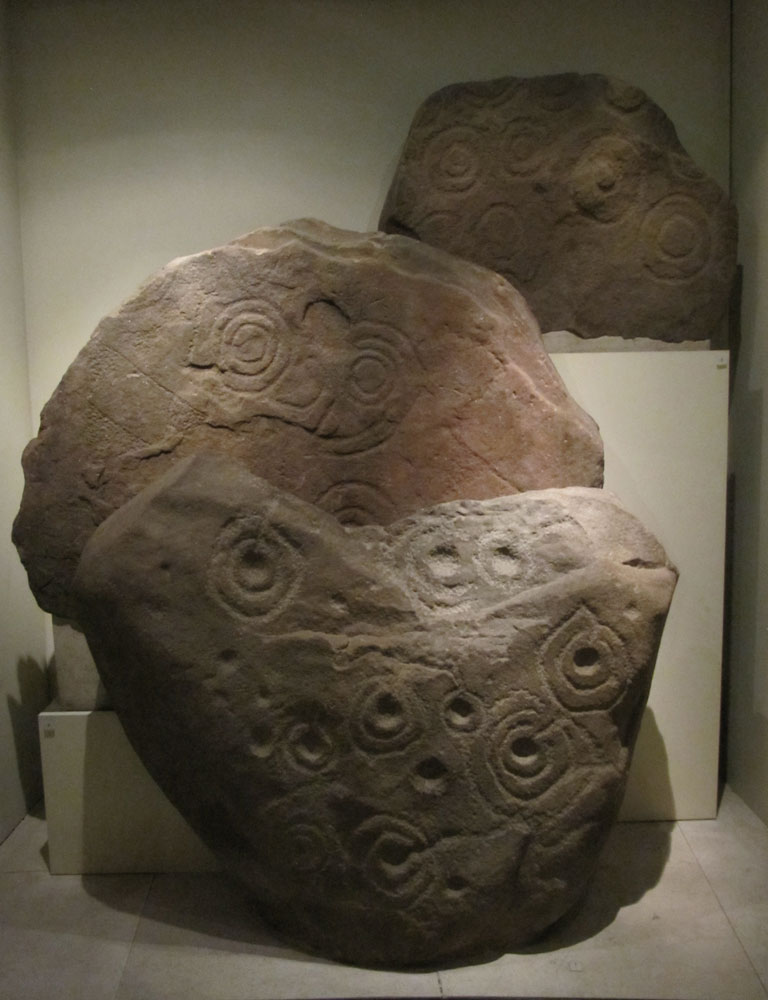
National Museum of Scotland (Pictish Stones) submitted by Anne T on 18th Jan 2018. A collection of 3 Pictish stones on display behind glass in Level -1 of the Tower. From front to back these are: Boulder from Letham Grange, Angus; Slab reused in a burial cist from West Yardhouse (?); and a slab from Lamancha.
(View photo, vote or add a comment)
Log Text: Pictish Stones at the National Museum of Scotland: See visit report for the National Museum of Scotland (Early Christian stones). Also went to the Research Library and came away with some great information on all the Pictish Symbol Stones held by the museum, and the names/details of various reference books.
St Hilda's Church (Lucker)
Trip No.75 Entry No.1 Date Added: 21st May 2018
Site Type: Ancient Cross
Country: England (Northumberland)
Visited: Yes on 20th May 2018. My rating: Condition 2 Ambience 3 Access 4

St Hilda's Church (Lucker) submitted by Anne T on 21st May 2018. The cross base is nestled under trees and brambles, next to the grave of a lady called "Janet". This part of the graveyard has been neglected over a number of years. We thought the church might have made more of their socket stone.
(View photo, vote or add a comment)
Log Text: Cross base, St. Hilda's Church, Lucker: We had a walk around the churchyard, but were unable to find a cross base amongst the gravestones. We wandered down as far as the river, Waren Burn, which flowed to the east of the church. Not finding anything, we wandered into the church. There was no guide book, but there were laminated sheets detailing the history of the church and St. Hilda, which I photographed.
Having found the cross base on Pastscape, with the grid reference, I was very reluctant to give up the search. It did indeed take some finding, as it was completely buried under ivy in a very overgrown section of the churchyard. Typically, not having the gps with us when we needed it, common sense said that the cross base should ideally be at the eastern end of the church at the highest point of land before it started to drop down to the river below. I had to clamber over brambles and force my way through trees to get to this part of the churchyard. The cross base was next to the grave of a lady called ‘Janet’.
Long Nanny
Trip No.75 Entry No.2 Date Added: 21st May 2018
Site Type: Standing Stone (Menhir)
Country: England (Northumberland)
Visited: Saw from a distance on 20th May 2018. My rating: Condition 3 Ambience 3 Access 4
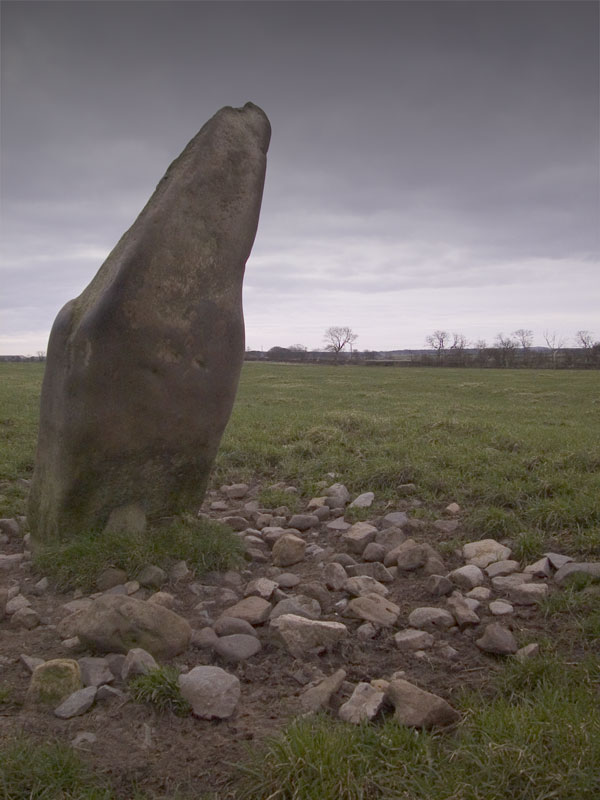
Long Nanny submitted by wayland on 31st Jan 2005. "Long Nanny" Close up showing rubble around base.
(View photo, vote or add a comment)
Log Text: Long Nanny Standing Stone, Tughall: On our way into Beadnell, on the B1340, husband Andrew screeched the car to a halt on the busy road, telling me there was a standing stone in the field that only had a couple of photographs on the Portal. We could only see this from a distance, as there were large cattle and a BIG bull in the field. I took a couple of photographs from the side of the road, although the stone was so far away, even resting the camera on the fence and the window ledge of the car, the shot was hazy.
Like wayland, I can’t find anything on Pastscape or Historic England. Intriguing. Need to go back and have a look when the bull and his ladies have been moved out of the field.
Tughall Chapel
Trip No.75 Entry No.3 Date Added: 22nd May 2018
Site Type: Ancient Cross
Country: England (Northumberland)
Visited: Yes on 20th May 2018. My rating: Condition 2 Ambience 4 Access 4
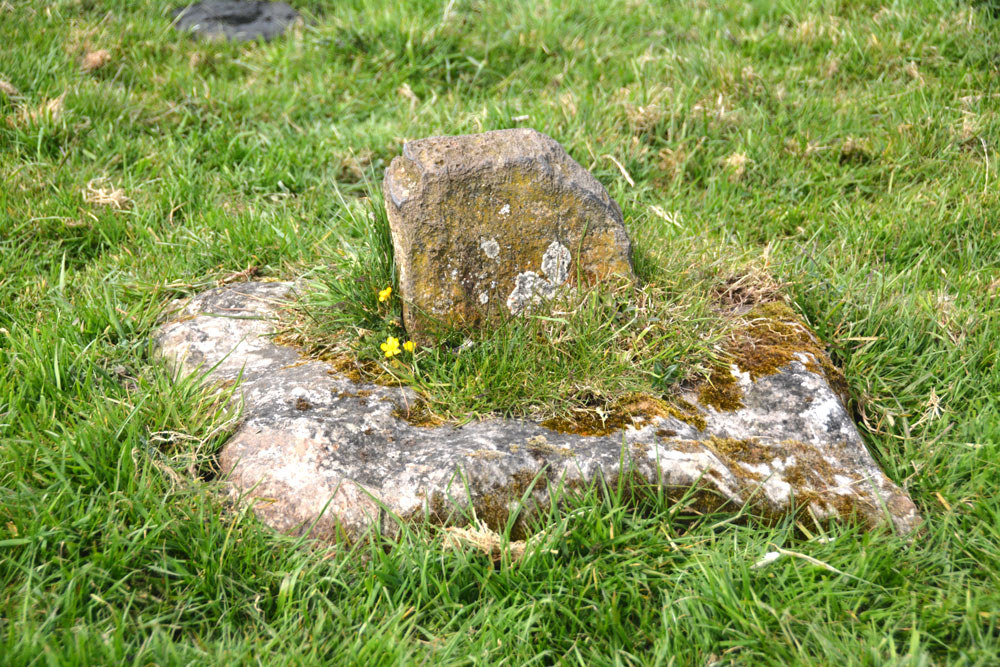
Tughall Chapel submitted by Anne T on 22nd May 2018. The socket stone and fragment of cross shaft from a different angle.
(View photo, vote or add a comment)
Log Text: Socket stone and cross shaft fragment, Tughall: Continuing along the busy B1340 from the Long Nanny standing stone, we turned right off the road towards Tughall Farm. There, the remains of the chapel stood above the road. We parked at a small layby just off the main road at NU 21427 26478, where there was a small gate into the field. This had been wired shut, so we walked round to the main gate at NU 21224 26486. There was absolutely no-one around to ask, and as the cattle were at the far end of the field, we let ourselves in.
The chapel is raised above the surrounding land. Only the tiniest bit of masonry remains (part of the apse, according to HE). The cross base is to the south of the chapel, almost next to what we initially thought might have been a hogback, but is only an old grave stone. I couldn’t see any writing on it.
The portion of cross shaft fragment remaining in the socket stone is very small and thin. I wonder what happened to the rest of it? [Note, this is on private land, but we didn't find anyone around in all the buildings on the farm to ask if we could take a look.]
Next stop, but not recorded on the Portal, was the lime kilns and harbour at Beadnell (too recent in time!)
St Ebba's Chapel
Trip No.75 Entry No.4 Date Added: 22nd May 2018
Site Type: Ancient Cross
Country: England (Northumberland)
Visited: Yes on 20th May 2018. My rating: Condition 2 Ambience 4 Access 4
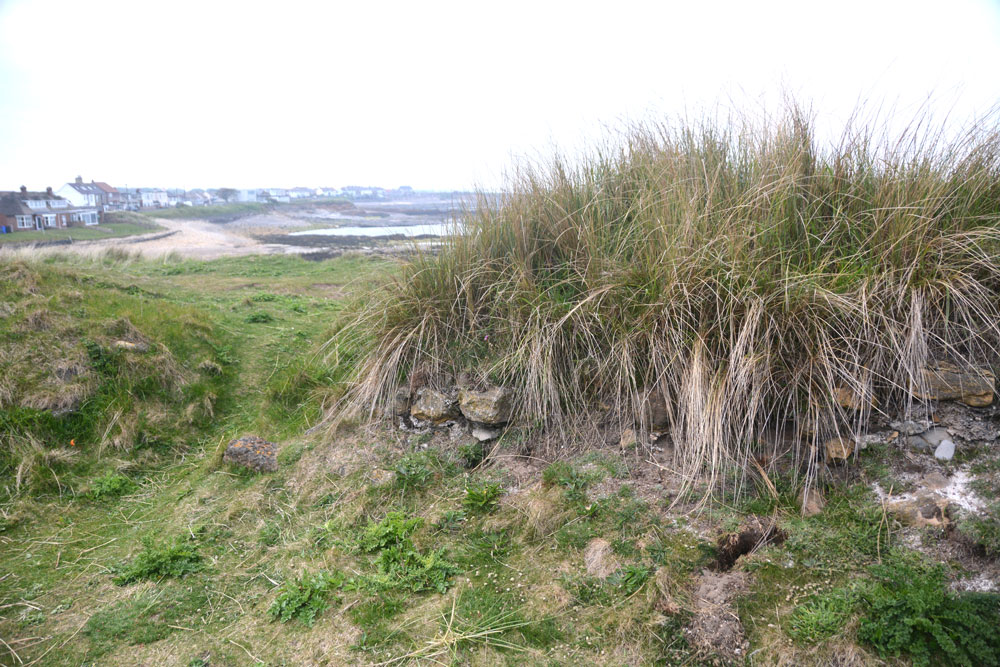
St Ebba's Chapel submitted by Anne T on 22nd May 2018. Inside the ruins of the chapel, looking at the northern doorway and remains of the northern wall.
(View photo, vote or add a comment)
Log Text: St Ebba's Chapel/Early Christian Monastery site: I have long wanted to come to this spot, ever since seeing the Time Team Excavation of this in July 2013. Whilst the rest of Northumberland had a hot day with blue, cloudless skies, this part of the coast was murky. Still, this was a very enigmatic place.
We’d stopped off at a café/restaurant in Beadnell village for refreshments before arriving here, and I’d looked at their guide book “Limekilns and Lobsterpots” before arriving, which intrigued me further.
A lonely spot, largely surrounded by sea on a narrow promontory. I wish I’d been able to see the excavations, but found the Wessex Archaeology report.
St Maurice's Well (Ellingham)
Trip No.75 Entry No.5 Date Added: 22nd May 2018
Site Type: Holy Well or Sacred Spring
Country: England (Northumberland)
Visited: Yes on 20th May 2018. My rating: Condition -1 Ambience 4 Access 4
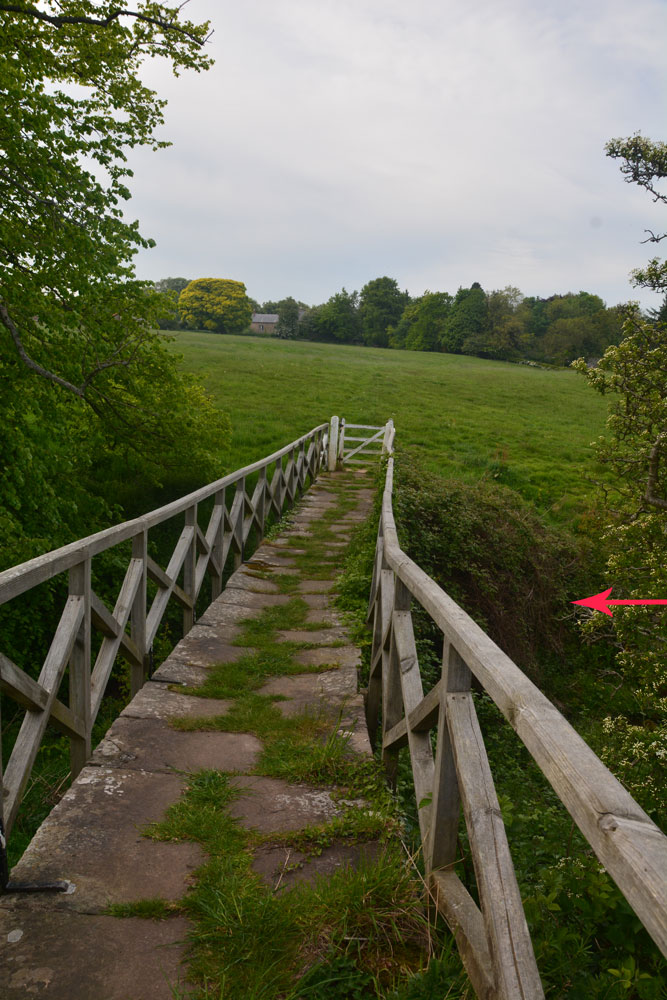
St Maurice's Well (Ellingham) submitted by Anne T on 22nd May 2018. We think this was the site of St. Maurice's Well, just to the south western side of this charming stone-flagged footbridge across the Long Nanny.
(View photo, vote or add a comment)
Log Text: St. Maurice's Well, Ellingham (destroyed): This church was in a glorious spot amongst old houses. The church looked relatively modern, and as it was still open, we popped our heads in. There was some really great stained glass windows. They also had a book sale, so we bought a couple of books on cathedral architecture for a £2 donation.
Inside, we spotted the head of an old font, dating (according to the church guide) to the Norman or Early English Church (but looked 16th/17th century in style to me). On either side of the path from the lych gate to the church were the old pinnacles from the previous church, dating to 1805.
Finding the right footpath from the church proved interesting, as it had a number of footpaths running from/around it, but we eventually orientated ourselves. Back to the Long Nanny stream.
From the description, we found the footbridge and the gorge/bank, but couldn’t really find any structures. I asked a lady (about 40ish) walking her dog if she knew where the well was. She replied “They used to come from the school to get the water. There used to be steps, but they’re gone, and no-one knows where the well was. It’s lost.”
We tried to find the location, which needed to be in a slight ravine (hence the reference to steps), and any old stonework. We thought we might have spotted something. But, then again, perhaps not! It was worth it to see the wonderful stone-flagged footbridge.
Five Ashes Cairn (Netherwitton)
Trip No.76 Entry No.1 Date Added: 27th May 2018
Site Type: Round Cairn
Country: England (Northumberland)
Visited: Yes on 26th May 2018. My rating: Condition 2 Ambience 4 Access 4
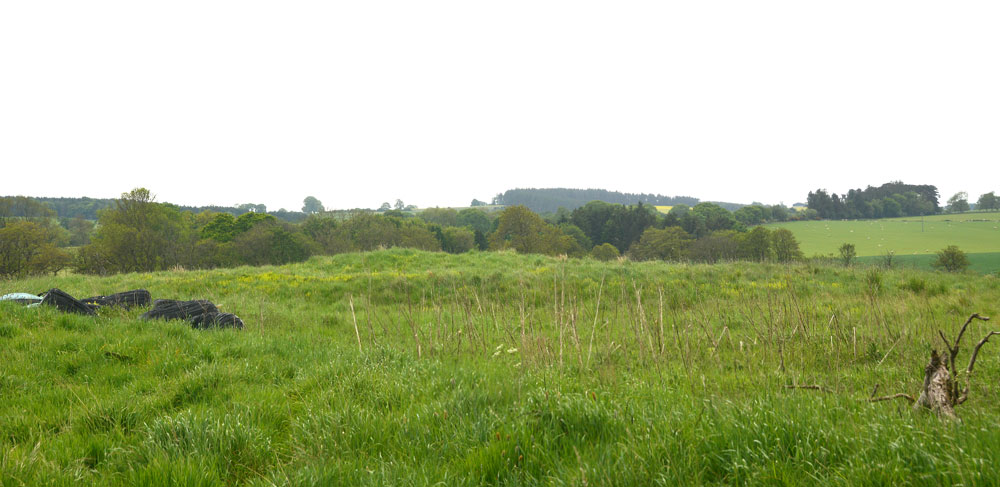
Five Ashes Cairn (Netherwitton) submitted by Anne T on 27th May 2018. First proper view of the Five Ashes Cairn from the gate into the field at approximately NZ 09596 90631. It is located on a slight rise in the landscape. The farmer has kept the area of, and just around the cairn, free of crops.
(View photo, vote or add a comment)
Log Text: Five Ashes Cairn, Netherwitton: From St. Giles’s Church, we drove back through Netherwitton, taking the right hand turn which runs northwards, to the west of the meandering River Font. Parking at NZ 09891 90457, next to the entrance to the field with the footpath running through, we set off across the mowed footpath. This section of shorter grass petered out after about 100metres. Five Ashes Cairn was visible to our west after about 300metres. There was a gate into the cairn field, technically trespassing, but the area with, and around, the cairn, had been left clear of crops, so we kept to the field edge and made our way the 50m or so across to the cairn.
At this time, a whole ribbon of small planes began to fly across, one at a time, about 30 seconds apart. I lost count after 20, then came the hang gliders and microlights, the some more small planes. They were all heading roughly from north east to south west, and we haven’t been able to find out where they came from, or where they were going to, although the Borders Gliding Club isn’t that far away from this location, near Milfield and Maelmin.
If we hadn’t have known this what we were looking at, and that it was marked on the OS map, anyone could have been forgiven for thinking this was just a farmer’s mound/junk heap with straw bales and other items left on its north eastern side.
This cairn looked quite large, with a steeper bank on its western side. It looks as if it has been crudely excavated, with various lumps and bumps under the long, tussocky grass (and lots of short, fierce nettles at ankle level!) over the mound.
Netherwitton B
Trip No.76 Entry No.3 Date Added: 28th May 2018
Site Type: Round Cairn
Country: England (Northumberland)
Visited: Yes on 26th May 2018. My rating: Condition 3 Ambience 4 Access 4
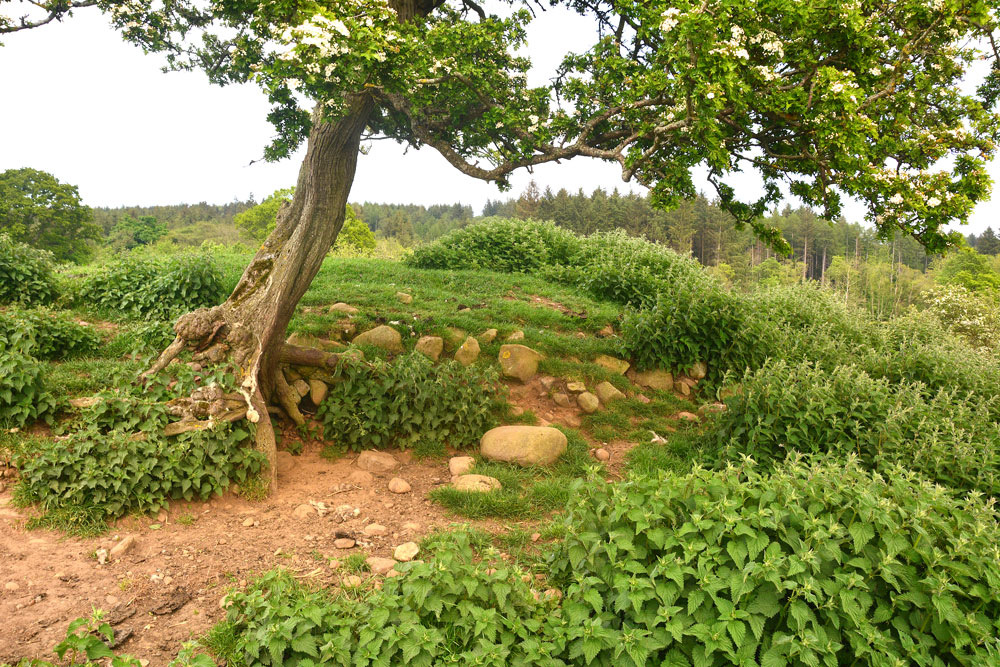
Netherwitton B submitted by Anne T on 28th May 2018. The internal structure of the cairn can be seen more clearly on its south western side, where a hawthorn tree has grown up from the base, and animal sheltering under it have rubbed away the surrounding earth.
(View photo, vote or add a comment)
Log Text: Netherwitton Round Cairn B: This cairn is located in a really lovely spot, on what was a small promontory, one side forming an old bank of the River Font, the river having changed course many years ago. We walked past this without realising this was the second cairn on the map, both saying: “That looks distinctly like a cairn”, then realising after I’d photographed it that it was the second Bronze Age cairn mentioned on Pastscape. Whilst small, it's a really nice example of a cairn, and the internal structure can be seen where a hawthorn tree grows out of its south west side, and animals have rubbed the earth away. This cairn has been apparently undisturbed by the antiquarians. I wonder why? Curious.
Netherwitton A
Trip No.76 Entry No.4 Date Added: 28th May 2018
Site Type: Round Cairn
Country: England (Northumberland)
Visited: Yes on 26th May 2018. My rating: Condition 3 Ambience 4 Access 4

Netherwitton A submitted by Anne T on 28th May 2018. This photo is three stitched together and shows the southern edge of the cairn, with its stony structure.
(View photo, vote or add a comment)
Log Text: Netherwitton Round Cairn A: This cairn is clearly visible from both Five Ashes cairn and Netherwitton B. There were some magnificent sheep and lambs in this field, all seemingly oblivious to the ancient monument underneath their hooves. All of them scattered as we approached the cairn. My first impression was ‘how many tens of thousands of stones did they use to create this cairn?’; the second ‘the interior has certainly been hacked about by whoever excavated this’.
We walked all round the higher outer bank of the cairn – it’s big. A very pleasant walk, to see three Bronze Age cairns very close to each other. This must have been a thriving community back in the day, especially with the River Font to the east and the Ewesley Burn to the west. I would have expected a standing stone or two to be in this area – it’s very fertile farmland here.
